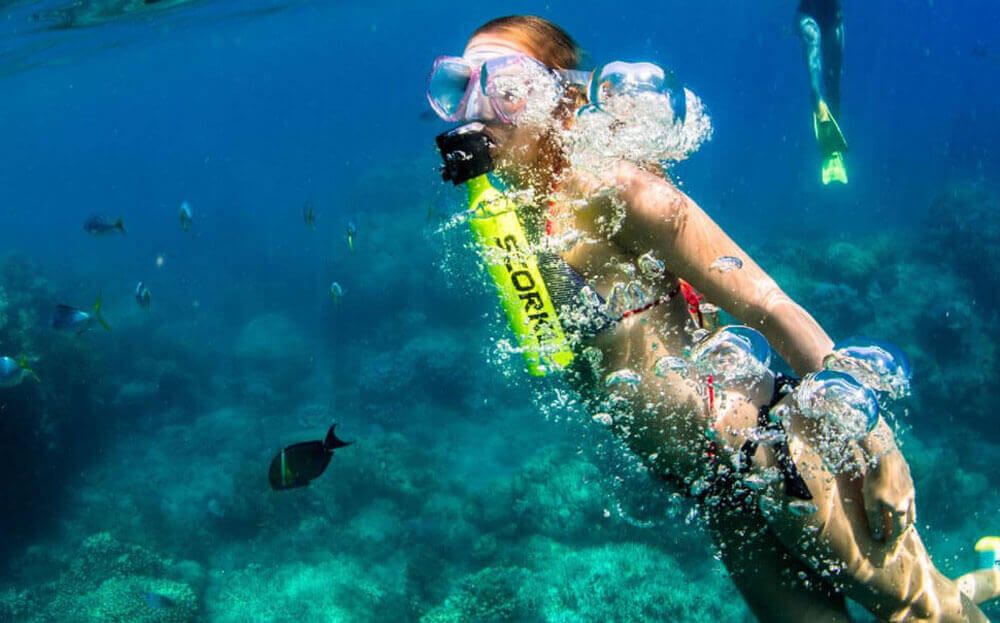
Two crowdfunded compressed air ‘snorkelling’ devices have been circulating on social media, causing an outpouring of shock and horror among the dive community.
The MiniDive (Indigogo) and Scorkl (Kickstarter) are small, 0.5-litre tanks with an attached regulator and pressure gauge.
The Mini-dive comes with a small harness worn around the chest, with a first and second stage regulator similar to a scuba system, and an attached pressure gauge.
The Scorkl is – basically – a Spare Air cylinder with a different label. It has a regulator and mouthpiece attached directly to the cylinder, with a pressure gauge mounted on the mouthpiece which can only be read by removing the device from your mouth.
The MiniDive’s harness will at least help to prevent its loss, but the Scorkl has no security straps. If it falls out of your mouth, your air supply is gone.
The manufacturers explain at some length on their websites that there are safety considerations to be taken into account, and that rules and procedures must be followed. The MiniDive’s user manual, for example, states that you should ‘NEVER stop your respiration during your descent or ascent.’ But not until page six!

Both products set a maximum depth limit of three metres for uncertified divers. The maximum depths for each product are given as 50m and 20m for trained scuba divers, while the recommended limit is 10m in both cases. Neither product comes with a depth gauge.
Many commentators on dive forums have pointed out that they are ‘deathtraps and lawsuits waiting to happen.’ Experienced scuba divers would have no problem using these devices safely, but that is not necessarily the market at which these devices are being targeted. They are all promoted as a ‘safe’ alternative to ‘expensive’ scuba diving, with no training required.
A half-litre tank pressurised to 200bar means you have around 75 litres of air to breathe before you hit 50bar. Air consumption is difficult to measure, but the average tidal volume (the bit we breathe in and out during a normal breath cycle) of the human lung is 0.5 litres, and the average breathing rate of an adult is 12-20 cycles per minute, and so in theory, it would be possible to breathe from these devices for 12.5 minutes.
But those figures only apply to healthy adults at rest. The added exertion of swimming alone could easily reduce that figure by half. Taking breaths of 1.5 litres, 20 times per minute, would mean red-lining in 2.5 minutes – at the surface. At 10m, this translates to 1 minute and 15 seconds of air before reaching 50 bar – or 1minute 40 seconds before emptying the tank dry. At the ‘maximum’ depths of 50m or 20m, the air supply is reduced to mere seconds.
While the recommended ‘safe’ limit of 3m makes the risk of lung overexpansion injuries unlikely, it does not rule them out entirely, and a breath-hold ascent from 10m would almost guarantee that a user suffers a life-threatening rupture of the lungs. The risk of decompression sickness is very small, but cannot be completely ruled out, especially if people repeatedly and rapidly bounce up and down to deeper depths. Since neither product comes with a depth gauge, there is no way for users to accurately judge their depth or ascent rate.
The manufacturers point these things out on their websites, but there is a whole world of difference between reading a user manual and having the technicalities explained by a qualified instructor.
Pre-existing medical conditions may have an effect. The consequences of an exercise-induced asthma attack at 10m while using compressed air are potentially severe. Scuba diving medicals used prior to training are mostly self-assessments, but they do go a long way to preventing complications underwater. Training at least raises the awareness of problematic medical conditions and the opportunity for further discussion with a dive professional, or medical doctor if necessary.
Aside from the safety aspect, it’s difficult to see what utility these devices have, given that they allow the user such a short time underwater.
Videos on the manufacturers’ websites show people scraping the hull of a small boat and fixing a propeller. Anybody who has ever had to free a fouled propeller will know that it can take a great deal longer than 10 minutes, and be very hard work.
The small tanks can be quickly filled from a regular scuba cylinder or compressor, or by use of a purpose-built hand-pump, which can take up to 30 minutes. Either way, for practical purposes, the time and effort involved in performing underwater tasks may well be far greater than donning full scuba and getting the job done properly.
That there are risks associated with scuba diving is without question, and possessing a certification card does not guarantee a diver’s safety – even experienced divers make mistakes – but even the most basic ‘intro’ dive from a reputable operator includes a safety briefing, basic skills training, and will be supervised by a certified scuba diving professional. Furthermore, should any incident occur, medical equipment and emergency oxygen supplies will be on hand.
It’s all very well providing a detailed user manual, but the risks of diving even to shallow depths on compressed air are substantial. Scuba training programmes are there for a purpose, and the preponderance of evidence shows that they go a long way to reducing accidents.
It would be one thing for a certified diver who understands those risks to purchase such a product, but allowing the use of compressed air underwater, without training and without additional safety precautions may well be lead to disaster.
As one commentator on the Kickstarter page put it: ‘This is a suicide device, wrapped up as a toy.’


